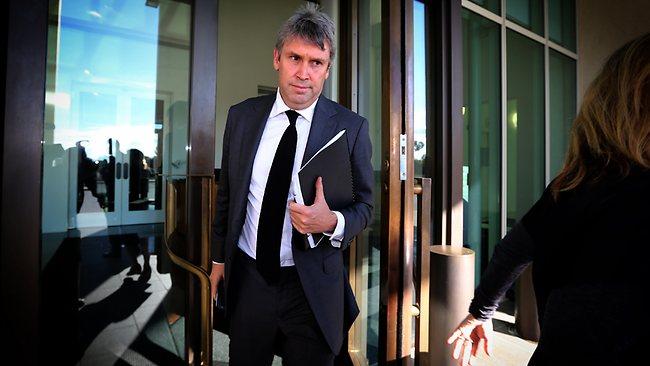Down-to-earth approach to floats
HOW many stockmarket floats will fit into a Christmas stocking? Not all of them, it seems.

HOW many stockmarket floats will fit into a Christmas stocking? Not all of them, it seems, after the surprise shelving this week of what was to be a $1 billion float of Bis Industries, a mining services company.
Now, of course, it's true that Bis Industries never had the same universal recognition as the forthcoming float of Dick Smith, a retailer everyone knows.
Nor had Bis Industries the cachet of the Nine Network, which made a lot of money for the Packer family, at least, in the days when everyone sat around the living room, happy to see what was on telly.
Still, the withdrawal of the Bis float was a shock because until this week it seemed just about anything could be floated on our suddenly giddy stockmarket: for example, The Pact group, an offshoot of the packaging empire belonging to the late Richard Pratt, is a $1.7bn industrial float that was oversubscribed in recent days. Likewise floats that have had no apparent sizzle factor whatsoever, such as the recent IPO of Sealink (think Captain Cook cruises) have, well, floated very successfully indeed.
We're in the "mad rush" phase of the IPO cycle - there's been nothing like it since the late 1990s when it reached a crescendo in March 2000 just prior to the dotcom crash. This 2013 mad rush is broader and more convincing than that remarkable period because there are very solid reasons investors are looking to the stockmarket for accumulated returns, most of all because money kept in cash is getting the lowest rates in 50 years.
For investors, the issue is whether there is money to be made in these floats: opportunity might arise either in the early days with the chance the brokers have somehow left "something on the table" for retail investors or the prospect of investing in a company that was previously in private hands.
It's certainly hard not to be lured into the game when news of high returns flows around the investor market. On the ASX we've just seen the extraordinary listing of Freelancer.com, which did not just lift when it joined the stockmarket two weeks ago. Rather, it virtually catapulted from its debut price of 50c.
But here we must investigate a little closer: Freelancer, an online outsourcing leader, only listed a sliver of itself on the stockmarket ... when it came to the boards the wider market quickly realised big name investors such as the Bassats, the Liebermans and the Darling family had been in early and and before you could say the words "dotcom mark II", Freelancer had tripled its share price to $1.50. Freelancer has remarkable potential but it also carries remarkable risk. Either way, its current pricing cannot be justified on a rational basis.
In this sort of atmosphere anyone who ever had it in mind to float their company gets out the calculator. A case in point is the pending float of the Pact Group. The business owners, Raphael Geminder and Richard Pratt's daughter Fiona, had tried repeatedly in recent years to test the market for a float. Yet even with their connections (for example, Geminder's brother-in-law, the remarkably successful value investor Alex Waislitz), the float could not get up. Nonetheless, they return this year with a highly geared industrial with an IPO on 13 times earnings and they get more money in initial subscriptions than they require.
When you get this sort of buzzed-up market, sooner or later serious tests come along. Indeed even in the best of times - such as now - there are dud floats. Just witness the miserable launch of health insurance company ISelect which listed at $2 in July and today trades at about $1.10.
On a deeper level, investors have long memories - the dud float of the Myer in 2009 will never be forgotten by those unlucky enough to participate in the float at $4 when private equity owners TPG got out fast, and now four years later the stock is trading at $2.86.
No surprise then that the closest float to Myer in terms of size and iconic status, the $2bn Nine Network IPO, poses an array of questions.
The first question must surely be, isn't the core business of free-to-air TV on the slide? And the short answer is yes.
More to the point, is the Nine Network float good value? You'd have to be brave, says anyone with a short-term memory. If it's short term, you'll remember CVC private equity took a bath a few years ago, while a long-term memory will remind you that Alan Bond took a gigantic bath on the same outfit a decade earlier.
On the hard numbers, the Nine Network floats on eight times earnings and the sellers - another combination of private equity players - are leaving about one-third of the company's funds inside.
Clime Asset Management's John Abernethy points out that Nine offers mediocre return on equity of just 8 per cent when you'd like to see around 15 per cent.
But Abernethy, a value investor, leaves his deepest scepticism for the float of Dick Smith (IPO on 13 times earnings) where a company that was sold by Woolworths for less than $100m a year ago is expected to underpin a float worth more than $500m: is Woolworths management really that naive? Or perhaps it's new investors that are the gormless ones, expected to believe such a remarkable turnaround has been fully effected, not to mention sustainable.
Moreover, if Dick Smith is now so strong, how come the private equity players are taking out fully $405m of the $418m raised?
Neither of these big-name iconic floats are convincing investments, says Abernethy. But then of course Abernethy is a rational value investor ... and hey, who's rational in a pre-Christmas float frenzy?



